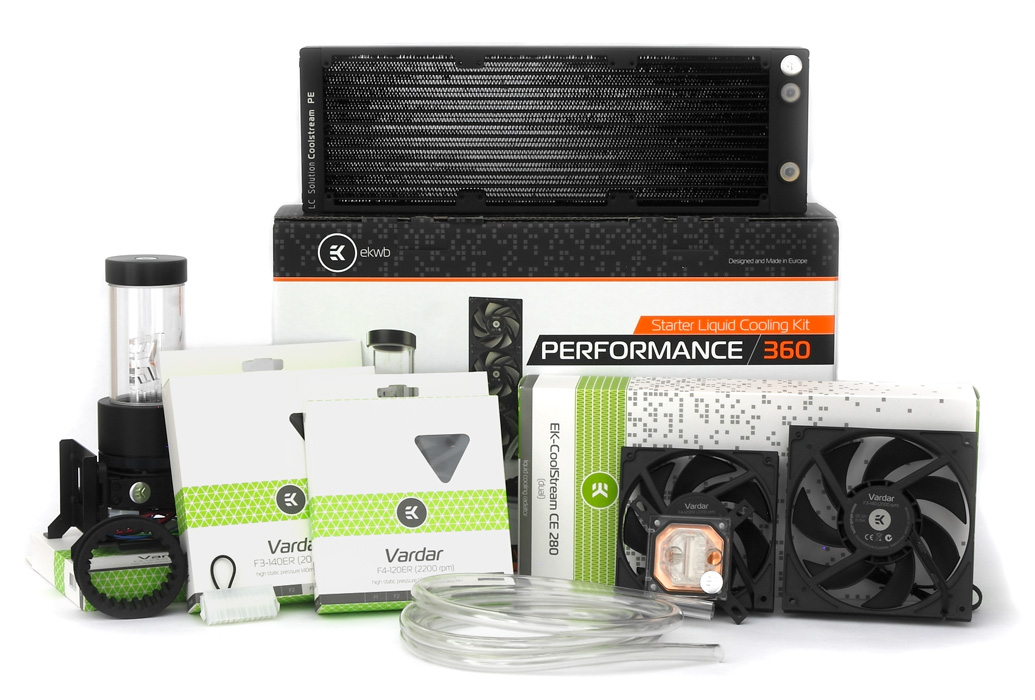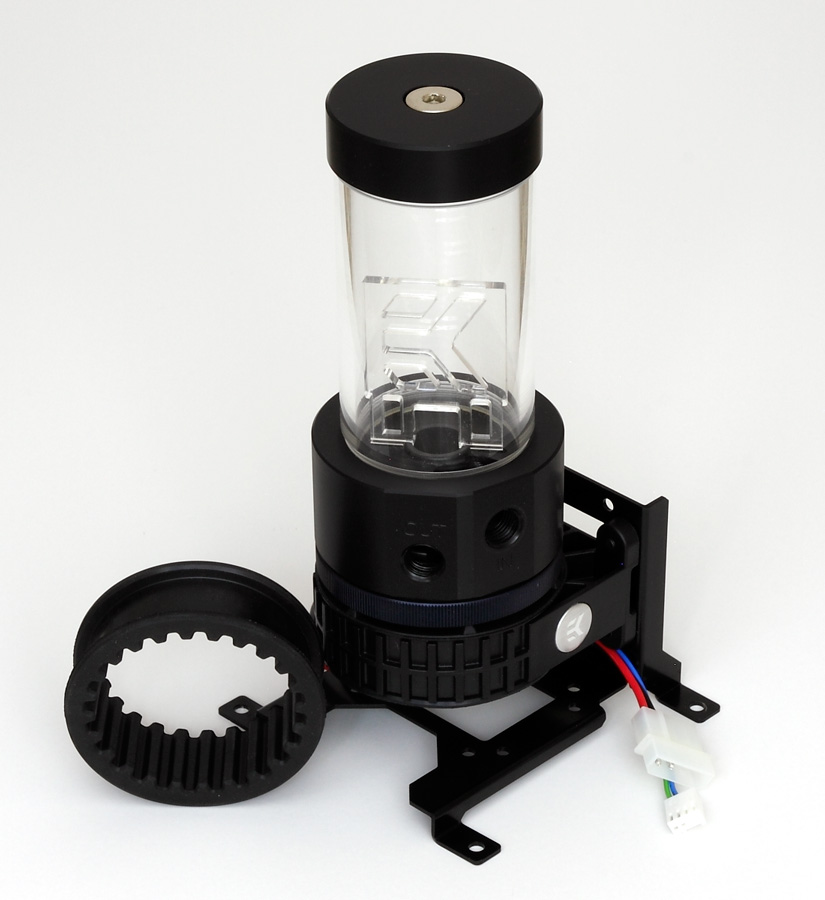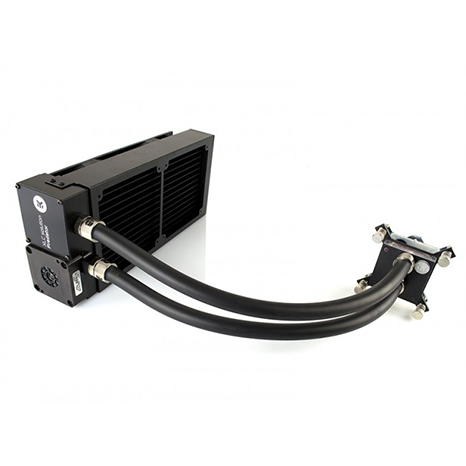Early Verdict
If you absolutely need the most cooling possible, these kits eases the transition to high-end liquid cooling.
Pros
- +
Fantastic cooling
- +
Excellent construction
- +
Copper radiator core
- +
Expandable
- +
Very quiet at lower fan speeds
- +
Extended PWM range support
- +
Compatible with all current sockets
- +
Configurable waterblock for any CPU.
Cons
- -
Expensive
- -
Time intensive to install
- -
Open loop means regular maintenance required
- -
More cooling than most people need
- -
Short warranty.
Why you can trust Tom's Hardware
Introducing EK Performance Kits
Liquid cooling can be a touchy subject among computer enthusiasts. While air coolers generally offer better performance value for most desktops, some space-constrained cases and hot CPUs need the extra cooling capacity that liquid affords. Sealed all-in-one liquid coolers are the most commonly used because they are more affordable and convenient. While open-loop setups offer better cooling and customization, they're also costlier and more complex. Today I look at two kits from EK that seek to alleviate those problems.
When getting an air or AIO liquid cooler, you only need to check that it fits inside your case and can mount to your CPU socket. Shopping for a custom loop requires you to answer a bevy of additional questions. Is the pump strong enough for the entire loop? Did you get the right size tubing? Did you get the right size fittings for that tubing? Do the fans have enough static pressure to deal with the radiator? Even if all your parts work together, it's still not uncommon to forget one or two things when you place the order (maybe clamps for the barb fittings or a mounting bracket for a reservoir). If you could add one SKU to your digital shopping cart that guaranteed compatibility between all the components and included all the necessary parts, fittings, accessories, and tools to put it together, would that be worth something to you?
That's exactly what comes in this box. The Performance line is second from the top in EK's liquid cooling kits (the others being Slim, Liquid, and Extreme). Inside you get EK's premium Supremacy Evo waterblock, mid-level PE or CE radiator (for 120mm or 140mm fans, respectively), EK's Vardar high static pressure fans, and D5 pump/reservoir combo. However, all this doesn't come cheap. The P280 and P360 each retail for about $370. As always, we at Tom's Hardware seek to find out if the juice is worth the squeeze. Let's explore each piece in depth.
Waterblock
The Evo waterblock in the Performance kits has a clear acrylic top and bare copper base. The top has two 3mm holes in the side meant for LED mounting (an LED cable is included in the kit). The Evo improves upon the MX block in the Predator with a larger microfin array on the cold plate for better heat transfer. Like the recently reviewed Predator, the Evo has an excellent mirror finish and is mostly flat. However, that flatness can change, as I'll explain.
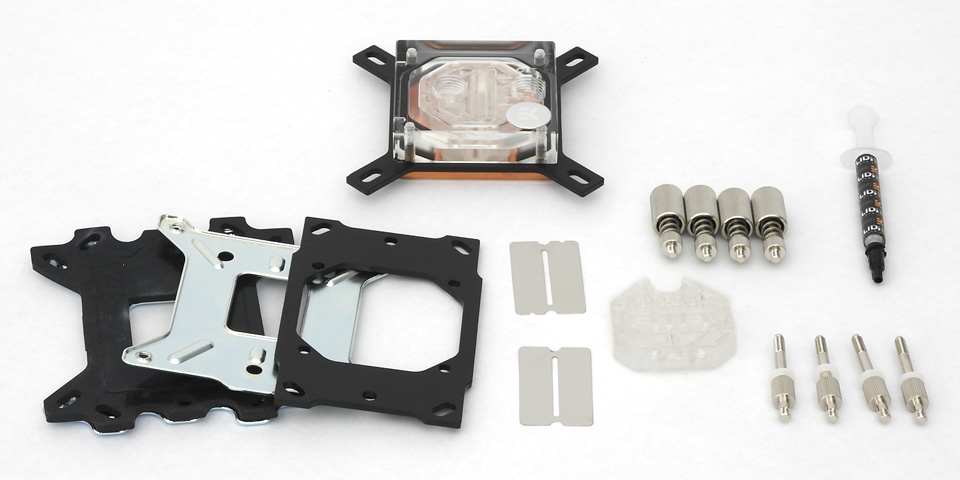

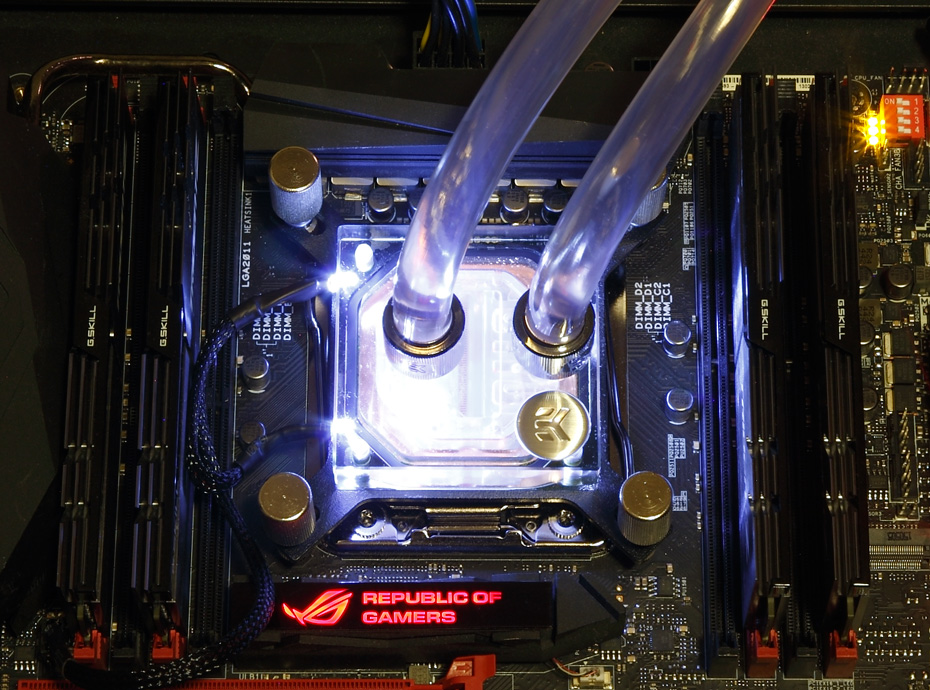
Unlike the MX, the Evo comes with an additional insert and two jet plates. These can swap out the stock parts inside the block to change how the water passes over the fins. It also changes the height inside the block to slightly alter the cold plate's concavity to best match the CPU's heat spreader. The installation manual includes a chart showing the recommended insert and jet plate combination for each supported CPU.
Unlike the Predator, the Performance kits include mounting hardware for all current Intel and AMD sockets, as well as quite a few older ones. Backplates and gaskets are enclosed for 775, 1366, 115x, 939, 754, 940, AMx and FMx sockets (2011-3 of course uses a built-in support plate). Two sets of standoff screws, nylon washers, springs, and thumb nuts complete the installation hardware along with a large tube of Gelid's excellent GC-Extreme thermal paste. Included tools consist of a hex key to disassemble the waterblock and Torx wrench for removing pre-installed plates on some motherboards.
Pump
The Performance 280 and 360 kits both use a Xylem D5 type pump matched to EK's XRES 140 Revo reservoir. The pump is rated for up to 1500 liters per hour, 4800 RPM, and a maximum pressure head of 3.9 meters. The pump is powered off a 12V Molex cable but supports PWM speed control over a second 4-pin cable (tachometer and PWM signals only). I would prefer a SATA power cable instead of Molex to keep wiring inside a case simpler. At full power the pump draws 23W.
Get Tom's Hardware's best news and in-depth reviews, straight to your inbox.
The reservoir holds 200mL of coolant and has clearly labeled in and out ports. An anti-vortex paddle, foam insert, and 12mm tube are included if your particular setup suffers excessive cyclonic forces (the paddle and tube cannot be used simultaneously). The top cap has a standard G1/4 plug that can be used to connect an exterior fill port.
The mounting clip for the pump comes with two rubber dampers to decouple pump vibrations from the case, one regular density and the other much softer. An additional bracket is supplied that can mount the pump any place a standard 120mm fan can fit. The pump can be mounted using both vertical and horizontal orientations. The soft decoupling ring is not recommended for horizontal mounting, though I had no problems using it that way. If you can't find a suitable fan slot to use the universal bracket, the kit comes with an adhesive template to drill your own mounting location anywhere in your case.
As with the waterblock, all necessary mounting screws, washers and hex keys for both mounting screws and reservoir plugs are in the package.
Radiator
While the Predator uses a specially modified radiator for its fully integrated design, the Performance kits use EK's standard CE 280 and PE 360 radiators for the respective sizes. Aside from the obvious difference in length and width to accommodate different fans, the CE 280 is 8mm thicker than the PE 360 model (45mm compared to 38mm). This results in a larger 290mL coolant capacity compared to 200mL in the PE 360. The PE 360 compensates for this by having a denser fin array at 19 fins per inch (the CE 280 is only 16 fpi) using the same split V design seen on the Predator.
Liquid cooling enthusiasts will be happy to know both radiator cores are H90 copper with brass chambers and fittings. Cheaper radiators often use aluminum in their cores which can lead to chemical corrosion between it and the copper found in other places in cooling loops. The only aluminum in EK's radiators is found along with steel in the exterior housing. The two G1/4 ports are recessed on both radiators, but brass extenders are pre-installed. Neither radiator has a separate fill port.
Overall construction is solid and stiff, though the black spray coating does scratch easily. One place for improvement is in the radiator mounting points. Some tags and shavings are left from drilling the screw holes. Also there are no safety stop plates behind the mount points. EK's supplied screws are perfect length to stop before coming into contact with the pipes and fins, so this isn't generally an issue. If for some reason you use different screws to attach fans or mount the radiator in your case, make sure they are proper length so you don't puncture the core.
Fans
The fans are the other difference between these two kits. Both use EK's Vardar fans, which have been specially developed for radiator use. The name comes from the cold winds that blow down the Moravia-Vardar gap in the mountains of northern Greece. EK is currently updating its kits so I got the newer F4-120ER and F3-140ER fans that will be shipping with the new revisions (these are the same fans that are on the Predator). The newer models feature a new all black color scheme and slightly faster maximum speed – 1850 to 2200 RPM for the 120mm fan, 1600 to 2000 RPM for 140mm. The ER in the name stands for extended PWM range, allowing them to run as low as 25% duty cycle. Older 140mm fans could already reach 30%, but the last-gen F3-120 fan was only rated to 50% duty cycle.
Both fan sizes are rated for a maximum static pressure of 31 pascals, though the larger fans of course move much more air (184 cubic meters per hour as opposed to 131). The fans are rated at 33.5 dBA and 40.7 dBA, with the 140mm fans being louder, though it's unlikely either will be run at full speed outside overclocking contests. Both use a double-ball bearing that's rated for 50,000 hours MTBF and are powered over a typical 4-pin PWM cable. A fan splitter cable comes with each kit allowing all radiator fans to run off the same motherboard fan header. You don't get any grommets or O-rings to dampen the fan vibration from the case. This usually isn't as big a concern on radiators as on tower coolers, but it wouldn't be unappreciated either.
The Rest
Aside the main kit components, you also get 2 meters of clear 13/10mm (3/8" inner diameter, 1/2" outer diameter) DuraClear tubing, six G1/4 nickel plated compression fittings and a 100mL bottle of EK's coolant concentrate (enough for one liter of coolant). I'm pleased EK includes threaded compression fittings as I find them much easier to use than separate barbs and clamps. To install the fittings to the radiator and waterblock you get a large hex key that fits (rather tightly) inside the fittings. Sadly you don't get a key large enough to undo the brass extenders on the radiators – I accidentally stripped the coating off one when trying to separate it from the compression fitting when swapping out the radiators. Another useful addition is an ATX power supply bridge that lets you turn on your PSU without it being connected to your motherboard. This lets you fill and leak test the loop prior to final installation in your case.
EK Liquid Cooling Comparison
MORE: Best CPU Cooling
MORE: How To Choose A CPU CoolerMORE: All Cooling Content
MORE: In Pictures: 20 Clever Liquid-Cooled PC Setups
- 1
- 2
Current page: Introducing EK Performance Kits
Next Page Installation, Test Configuration, Results And Final Analysis-
blppt Maybe if you could test a premium closed loop cooler alongside as well, for comparison? Or something like a H115i?Reply -
RedJaron It's already tested against a Predator, which, while expandable, is set up to be a sealed loop also.Reply -
thundervore Reply18772536 said:Maybe if you could test a premium closed loop cooler alongside as well, for comparison? Or something like a H115i?
Testing a custom loop against a AIO is not a good test. The AIO will always loose.
This is because the AIO does not have that much liquid and made with inferior parts (weak pump with built in block, aluminum radiator)
Testing a custom loop with only go head to head with other custom loops like Swifttech, -
blppt Of course the AIO would lose, but for those of us iffy about putting together an open loop, it would have been nice to see by how much.Reply -
1800Allen What would be great is to see the value vs cost vs performance of adding a GPU block in there. It is the next logical step for someone who is getting into water cooling. I know there is GPU addin kits for the Predator line, using the same block and swapping connectors for your custom loop would give some insight on all 3 kits value.Reply -
RedJaron Reply
As I already said, I compared this against a Predator 240. I think more than a few people would consider that a "premium" AIO. You can see how much better the Performance kits were if you looked at the graphs.18774239 said:Of course the AIO would lose, but for those of us iffy about putting together an open loop, it would have been nice to see by how much.
Depends on where you put the value. In straight performance / cost, the more money you put into a custom loop, the more the value drops. You're simply too far past the ideal return on investment point. As I said in the review, you can almost always get better performance value using air. A GPU block is also $100+ on top of the cost for the rest of the loop, which makes it even more cost prohibitive.18774295 said:What would be great is to see the value vs cost vs performance of adding a GPU block in there. It is the next logical step for someone who is getting into water cooling. I know there is GPU addin kits for the Predator line, using the same block and swapping connectors for your custom loop would give some insight on all 3 kits value.
If your value is on noise or consistent temps that allow less thermal throttling, then that's a slightly different matter. However, you're spending $100s to get that small benefit, so again, value in the traditional sense isn't much a factor. -
zodiacfml Didn't notice immediately that this is a different cooler to Anandtech's review.Reply
Am i missing something, that it has 30 degrees above ambient? -
n0ns3ns3 Reply18776518 said:Didn't notice immediately that this is a different cooler to Anandtech's review.
Am i missing something, that it has 30 degrees above ambient?
So ?
let's say the ambient is 25C, so it makes overclocked 6 core 140w (before overclock) CPU to run Prime95 at 55-60C.
That's quite amazing. -
RedJaron Reply
You'll need to specify which Anand review you're referring to as they've covered more than a few liquid coolers.18776518 said:Didn't notice immediately that this is a different cooler to Anandtech's review.
Am i missing something, that it has 30 degrees above ambient?
But yes, Nonsense has explained the temperature delta. The ambient temp during my tests was between 20 - 24 °C ( day to night fluctuation, and yes, I recorded the beginning and ending ambient temp of each test ). The P280 and P360 keep this CPU at least 15° cooler than some of the best big air coolers like the D15 and Dark Rock Pro 3. You just pay more than three times the money for these liquid kits, which is why it only gets an Approved award instead of Recommended.
